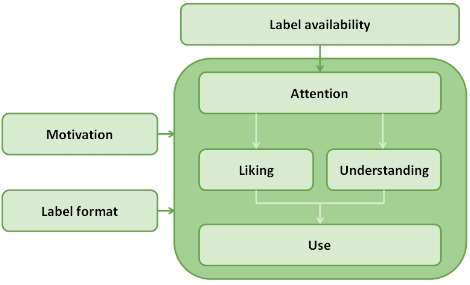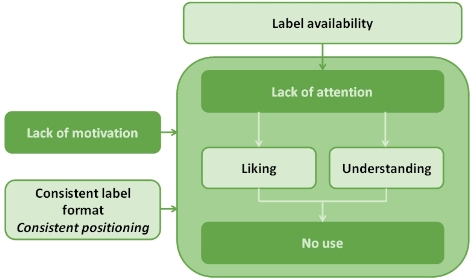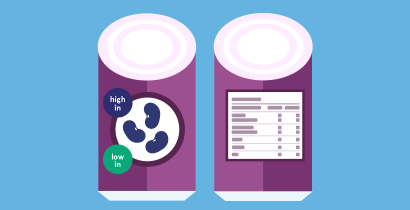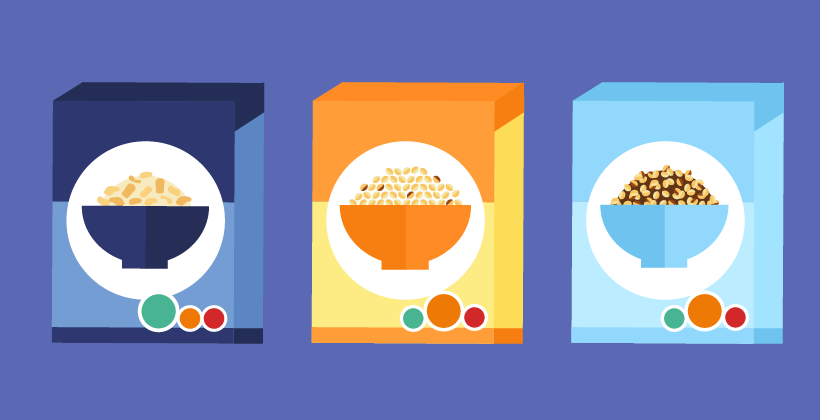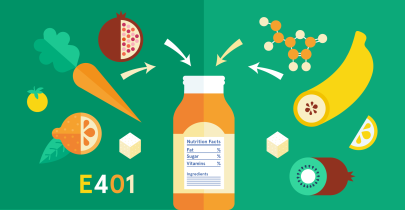New insights into nutrition labelling in Europe
Last Updated : 30 March 2012Nutrition labels can help consumers make more healthful choices about food, but scientific insights into how these labels are used in real-life shopping situations are limited. The aim of the EU-funded project, FLABEL, was to further investigate the impact of nutrition labels on dietary choice among consumers in Europe.
Background
Previous reviews on nutrition labelling in Europe have shown that consumers are generally interested in nutrition information and like and understand simplified, front-of-pack labels, although they tend to over-report their use of nutrition information.1,2 However, these reviews have at the same time revealed gaps in our knowledge – namely, whether nutrition information is positively affecting the healthfulness of real-life food choices and, if so, which factors are responsible for such an effect.
It also seems that the different labelling formats used across Europe – such as Guideline Daily Amounts (GDAs), Traffic Lights, nutrition tables, and health logos – may stimulate a wide range of consumer reactions. This has made it difficult to evaluate existing labelling policies and to develop new ones.
What is FLABEL?
(Food Labelling to Advance Better Education for Life) is a small collaborative project which was set up to explore the relationship between label availability and dietary intake among consumers in Europe. The project had two main objectives:
-
To determine the effect of nutrition labelling on dietary choices, consumer habits, and food-related health issues in Europe.
-
To use these scientific findings to develop guidelines on the use of nutrition labelling for EU policy and the food industry, especially small- and medium-sized enterprises (SMEs).
The partners involved in FLABEL included academic experts, retailers, and non-governmental organisations. Together, they worked on a series of studies designed to discover the impact of nutrition labelling in Europe. The project started by assessing the availability of nutrition labels across the continent, and was followed by studies that examined the different ways in which consumers react to nutrition labels (see Figure 1).
Figure 1. The FLABEL framework showing the factors leading from label availability to label use. Assuming that nutrition labels are available on food products, any effect on food choice depends on consumers paying attention to these labels and understanding the label information. It also helps if consumers like the idea of nutrition labelling. Other factors such as the label format and consumers’ motivation to make healthful choices will determine how much consumers pay attention to labels, and how much they like, understand and use them.
What are the main findings?
Availability of nutrition labels
The availability of nutrition information on food products in Europe is very high. FLABEL researchers investigated over 37,000 food products in the EU 27 plus Turkey and found that the majority (85%) had back-of-pack nutrition information while nearly half (48%) had nutrition information on the front of the pack. The study looked at products across five product categories: sweet biscuits, breakfast cereals, pre-packed fresh ready meals, carbonated soft drinks, and yoghurts.3
The most widespread labelling scheme for the back of the pack was the nutrition table, where calories and nutrient composition are listed in a linear way. For the front of the pack, both nutrition claims and the Guideline Daily Amounts (GDA) label were the most widespread schemes.
Nutrition claims are labels which indicate that a product is high or low in a particular nutrient. For example, a product may claim that it is “high in fibre” or “low in saturated fat”. The GDA label shows the amount of energy (calories) and key nutrients (sugar, fat, saturated fat, and salt) per serving and highlights the percentages of the Guideline Daily Amounts for each.
Understanding nutrition labels
After establishing that nutrition labels are widely available in Europe, FLABEL researchers wanted to see whether people can understand and use the information provided by these labels. In a large-scale survey conducted in four European counties, consumers were given three products in a product category (e.g. yoghurts) and asked to rate the healthfulness of each. These ratings were then compared to an objective measure of healthfulness. The participants first rated the products using only information about the key nutrients and energy. Later, they were asked to do the same task using an additional standard labelling scheme: GDAs, Traffic Lights, a GDA/Traffic Lights hybrid label, or a health logo. The results show that providing this additional information only marginally improved participants’ accuracy.
In a smaller study conducted in the United Kingdom, participants were shown labels with information on key nutrients and energy for a variety of products and asked to rank the foods according to healthfulness. The participants belonged to one of three age groups: parents of children (25–55 years), 55+ years, and teenagers (14–17 years). The researchers observed that the majority of participants were able to complete this task correctly.
These studies demonstrate that consumers can understand the information presented in nutrition labels, in that they have no problems using this information to judge healthfulness. It also appears that their ability to do this is not affected by variations in the label format.
The importance of motivation and attention
Lack of motivation has emerged as a major bottleneck which prevents nutrition labels from having a positive impact on food choice (see Figure 2). While most consumers can identify the more healthful product out of a selection of food products, they are not motivated by health when actually choosing foods. Instead, they tend to rely on other criteria such as taste, family liking, and buying habits when asked to pick the product they prefer. This suggests that when it comes to using nutrition information to inform food choices, motivation – specifically, in the form of a health goal – is essential.
Motivation is also important for improving attention to labels – another bottleneck limiting the use of nutrition information. A mock grocery store experiment tracked the eye movements of consumers and found that they looked at nutrition labels for an average of between 25 and 100 milliseconds. This time period is too short for consumers to process the information. However, the experiment showed that if motivated by a health goal, consumers’ attention to nutrition labels increased.
Liking and using nutrition labels
One of the aims of FLABEL was to look at which label formats people like most. The results from a survey of 2000 consumers in four countries showed that the label consumers preferred – and said they would like to use most – was one that combined the Guideline Daily Amounts and Traffic Lights schemes. Familiarity also plays a key role: the more familiar people are with a label, the more likely they are to prefer and use that label.
Increasing attention to and use of nutrition labels
Given these results, what is the most promising approach for increasing attention to and use of nutrition information? As mentioned, increasing motivation can boost consumer attention and use. It is also important for information on key nutrients and energy to be provided in a consistent way on the front of the pack, ideally on 100% of food products. It is helpful if the nutrition label is big enough to be easily legible, presented in monochrome, and familiar to the consumer. If the overall density of information on the food packaging is lower, this can increase attention to nutrition labels as well.
FLABEL research has shown that complementing this basic nutrition information with a health logo can increase attention and use, especially in situations of time pressure, although these effects are not strong. Colour-coding may also lead to small increases in attention and use: in a couple of studies, the addition of colour-coding to nutrition labels appeared to increase the healthfulness of consumers’ food choice. This effect was small, however.
Overall, a more healthful assortment of products has a stronger effect on promoting healthful choices than the provision of label information. This is apparent from a study conducted in Germany and Poland in which consumers were asked to rate the healthfulness of sweet and savoury snack foods: when healthful foods were added to the selection of products, consumers began to make significantly more healthful choices.
Figure 2. The “bottlenecks” preventing nutrition labels from having a positive impact on food choice. Lack of motivation and lack of attention limit the use of labels as a guide to healthful food choices. Label format can have a positive effect on consumers’ reactions to and use of nutrition labels in some cases, especially if used in a consistent way.
Where do we go from here?
In November 2011, the results of the FLABEL project were discussed with stakeholders at a consensus workshop in Brussels.4 They included policy makers, industry, retailers and consumer organisations. Among other conclusions, it was agreed that nutrition labelling needs to be seen in a broader context. The results of this project have shown how health motivation is a major driver of label use. As such, rather than focus solely on the label itself, policy interventions should consider how labelling slots in to the “bigger picture” of nutrition education and health motivation.
Second, consistency and familiarity play a larger role in the success of nutrition labelling than any particular label format. This means that standardised guidelines on the use of nutrition labelling could help to improve consumer use. In particular, FLABEL data suggests that the widespread use of front-of-pack nutrition information would be the most effective option.
Finally, it was recognised among stakeholders that the use of nutrition labelling can act as a major incentive for product reformulation and innovation. Many manufacturers will strive to develop foods with a more healthful nutrient profile in order to be able to put certain health logos and nutrient claims on their products. This outcome is especially positive given that a more healthful selection of products was shown to promote healthful food choices among consumers.
Conclusions
The results of the FLABEL project have filled in some of the gaps in our knowledge about nutrition labelling in Europe. They show how labels are widely available on food products across the continent, and how consumers are capable of understanding and using nutrition information under certain conditions. At the same time, it is apparent that a lack of motivation and attention are significant bottlenecks when it comes to using nutrition labels to make more healthful food choices. Label format can help to increase attention, particularly if it appears in a consistent fashion on the front of the pack.
FLABEL has achieved a much greater understanding of the relationship between label availability and dietary intake among European consumers, which can be used to guide future policies on the use of nutrition labels in Europe.
MORE INFORMATION
FLABEL (Food Labelling to Advance Better Education for Life) was funded by the European Commission’s Seventh Framework Pogramme (Contract n° 211905) from April 2008 to January 2012.
The data gathered during the project will continue to be analysed and published in scientific journals. Information on accepted publications is provided on the FLABEL website, www.flabel.org, where you can also find a webinar presenting the full results of the project.
References
-
Cowburn G & Stockley L (2005). Consumer understanding and use of nutrition labelling: a systematic review. Public Health Nutrition 8(1):21–28.
-
Grunert K & Wills J (2007). A review of European research on consumer response to nutrition information on food labels. Journal of Public Health 15:385–399.
-
Storcksdieck genannt Bonsmann S, et al. (2010). Penetration of nutrition information on food labels across the EU-27 plus Turkey. European Journal of Clinical Nutrition 64:1379–1385.
